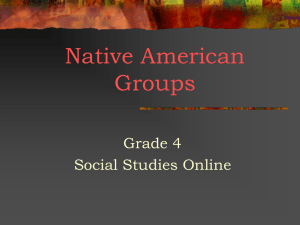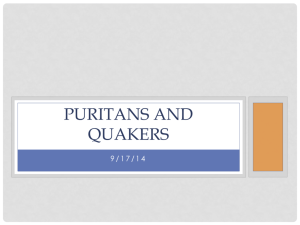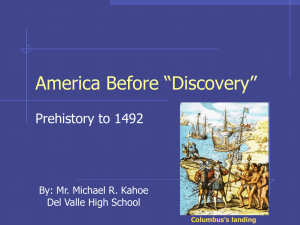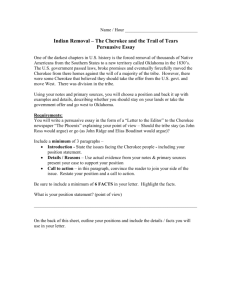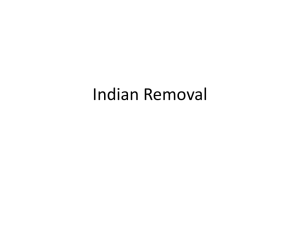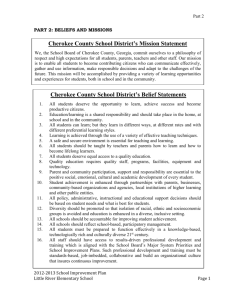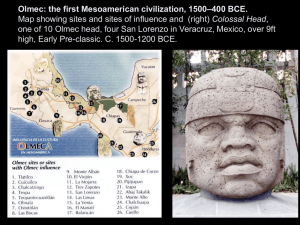4th Grade Content - emestigers
advertisement
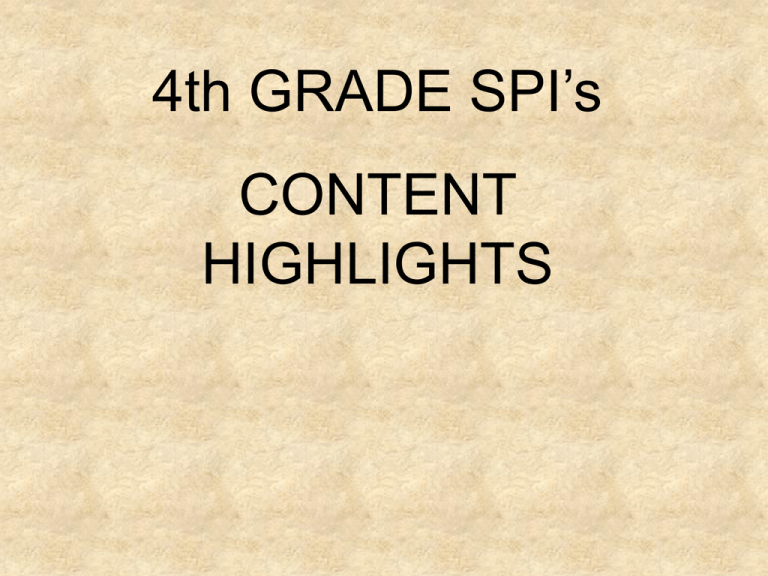
4th GRADE SPI’s CONTENT HIGHLIGHTS 4.1.1 identify pre-Colonial Native American groups ( i.e., Cherokee, Creek, Chickasaw, Aztec, Mayan, Olmec, Mississippi Mound Builders) 4.1.1 identify pre-Colonial Native American groups ( i.e., Cherokee, Creek, Chickasaw, Aztec, Mayan, Olmec, Mississippi Mound Builder) 4.1.1 identify pre-Colonial Native American groups ( i.e., Cherokee, Creek, Chickasaw, Aztec, Mayan, Olmec, Mississippi Mound Builder) 4.1.1 identify pre-Colonial Native American groups ( i.e., Cherokee, Creek, Chickasaw, Aztec, Mayan, Olmec, Mississippi Mound Builder) 4.1.1 identify pre-Colonial Native American groups (i.e., Cherokee, Creek, Chickasaw, Aztec, Mayans, Olmec, Mississippi Mound Builders) CHEROKEE, CREEK, CHICKASAW Wattle and daub houses are permanent structures that take a lot of effort to build. Like longhouses, they are good homes for agricultural people who intended to stay in one place, like the Cherokees and Creeks. 4.1.1 identify pre-Colonial Native American groups (i.e., Cherokee, Creek, Chickasaw, Aztec, Mayans, Olmec, Mississippi Mound Builders) CHEROKEE, CREEK, CHICKASAW Built permanent settlements Farmers and Hunters Adapted to white European traits more than other Native Americans 4.1.1 identify pre-Colonial Native American groups ( i.e., Cherokee, Creek, Chickasaw, Aztec, Mayan, Olmec, Mississippi Mound Builders) CHEROKEE, CREEK, CHICKASAW SEQUOYAH developed an alphabet for the Cherokee to use 4.1.1 identify pre-Colonial Native American groups ( i.e., Cherokee, Creek, Chickasaw, Aztec, Mayan, Olmec, Mississippi Mound Builders) OLMEC MAYAN AZTEC While the very earliest sites of the Olmec show relatively simple societies based on hunting and fishing, the Olmecs eventually established a highly complex level of political government, including public building projects such as pyramids and large platform mounds; agriculture; a writing system; and a characteristic sculptural artistry including enormous stone heads with heavy features reminiscent of angry babies. 4.1.1 identify pre-Colonial Native American groups ( i.e., Cherokee, Creek, Chickasaw, Aztec, Mayan, Olmec, Mississippi Mound Builders) OLMEC MAYAN AZTEC 4.1.1 identify pre-Colonial Native American groups ( i.e., Cherokee, Creek, Chickasaw, Aztec, Mayan, Olmec, Mississippi Mound Builders) MISSISSIPPI MOUND BUILDERS These people lived in permanent villages and hamlets. Early in their culture they farmed, gathered, fished, and hunted. One of their major agricultural accomplishments was combining the domesticated plants of the eastern agricultural complex of North America with corn and beans from Mexico. Because of this their way of life became based solidly on agriculture, rather than on gathering wild plant foods. 4.1.1 identify pre-Colonial Native American groups ( i.e., Cherokee, Creek, Chickasaw, Aztec, Mayan, Olmec, Mississippi Mound Builders) MISSISSIPPI MOUND BUILDERS The mounds were built over a period of decades. Each time a building was destroyed, the mound was given a new foundation and a new building was constructed on top. It still remains a mystery as to what function the mounds served. Perhaps they were for some religious or ceremonial purpose. 4.1.2 identify cultural groups who inhabited North America in the 17th century (i.e., Puritans, Quakers, Spanish, French) PURITANS Settled at Plymouth (Pilgrims) and Massachusetts Bay Came for religious freedom Believed in hard work, thriftiness, and devotion to God Pilgrims arrived on the Mayflower 4.1.2 identify cultural groups who inhabited North America in the 17th century (i.e., Puritans, Quakers, Spanish, French) PURITANS Had friendly relations with the Indians for awhile - but eventually turned hostile First THANKSGIVING 4.1.2 identify cultural groups who inhabited North America in the 17th century (i.e., Puritans, Quakers, Spanish, French) PURITANS Rocky soil - not very fertile - made life very hard Fishing in the Atlantic COD 4.1.2 identify cultural groups who inhabited North America in the 17th century (i.e., Puritans, Quakers, Spanish, French) QUAKERS Settled in Pennsylvania Colony founded by William Penn Quakers were persecuted for their beliefs 4.1.2 identify cultural groups who inhabited North America in the 17th century (i.e., Puritans, Quakers, Spanish, French) QUAKERS Believed that all people - men and women could speak to God Developed friendly relations with the Indians Did not tolerate slavery 4.1.2 identify cultural groups who inhabited North America in the 17th century (i.e., Puritans, Quakers, Spanish, French) SPANISH Settled mainly in Central and South America Christopher Columbus gave Spain her claim to the New World 4.1.2 identify cultural groups who inhabited North America in the 17th century (i.e., Puritans, Quakers, Spanish, French) SPANISH Settlements extended into Mexico and future southwestern United States Established missions to convert natives to Christianity CONQUISTADORES Main purpose - FIND GOLD and other treasures 4.1.2 identify cultural groups who inhabited North America in the 17th century (i.e., Puritans, Quakers, Spanish, French) FRENCH Settled in Canada FUR TRAPPING Very few permanent settlements - mainly trading posts Trappers lived in the wilderness and among the Indians 4.1.2 identify cultural groups who inhabited North America in the 17th century (i.e., Puritans, Quakers, Spanish, French) FRENCH Claims to the Ohio River Valley will bring the French and English into conflict French and Indian War 1754-1763 4.1.3 determine how groups resolve conflict (i.e., school, tribal councils, courts) NATIVE AMERICANS Formed confederations to make them stronger against the whites who pushed into their lands IROQUOIS CONFEDERATION 4.1.3 determine how groups resolve conflict (i.e., school, tribal councils, courts) NATIVE AMERICANS Allied with the Europeans Iroquois - British Huron - French 4.1.4 examine how Native American culture changed as a result of contact with European cultures (i.e., decreased population, spread of disease, increased conflict, loss of territory, increase of trade) TRADE - bartering at first Indians moved from a subsistence economy to a more commercial economy because of trading with whites 4.1.4 examine how Native American culture changed as a result of contact with European cultures (i.e., decreased population, spread of disease, increased conflict, loss of territory, increase of trade) DISEASE Indians had no immunity to European diseases - entire tribes wiped out by measles, influenza, and small pox 4.1.4 examine how Native American culture changed as a result of contact with European cultures (i.e., decreased population, spread of disease, increased conflict, loss of territory, increase of trade) CONFLICT increased as white settlers moved into territory that was home to different Indian tribes Indians pushed farther westward Government REMOVAL policies begun in the 1800’s to put Native Americans on reservations in Oklahoma 4.1.5 identify various racial and ethnic groups in TN at the founding of statehood (i.e., Cherokee, Creek, Shawnee, English, Scottish, French, American born pioneers) 4.1.5 identify various racial and ethnic groups in TN at the founding of statehood (i.e., Cherokee, Creek, Shawnee, English, Scottish, French, American born pioneers) Scots-Irish settled mainly in East TN Independent and self-reliant Includes ANDREW JACKSON 4.1.5 identify various racial and ethnic groups in TN at the founding of statehood (i.e., Cherokee, Creek, Shawnee, English, Scottish, French, American born pioneers) FRENCH Built forts down through the Ohio Valley 4.1.6 read and interpret facts from a historical passage about an early American Spanish mission 4.1.6 read and interpret facts from a historical passage about an early American Spanish mission 4.2.1 recognize the concept of supply and demand Free markets are governed by supply and demand. When supply is low and demand is great >> prices go up. When supply is high and demand is low >> prices go down. EXAMPLE - Colonial boycotts worked so well because demand dropped and British merchants were stuck with products they couldn’t sell or had to sell cheap 4.2.1 recognize the concept of supply and demand Cotton prized by England for its textile mills British demand fueled more cotton growth which led to more slavery Led to a belief in the South that “Cotton is King” 4.2.2 interpret a chart of major agricultural produce in TN (I.e., cotton, tobacco, soy beans, rice, corn, cattle, wheat, swine, sheep) http://www.nass.usda.gov/Statistics_by_State/Tennesse e/index.asp Value of Tennessee Crops 350,000,000 Value in Dollars 300,000,000 250,000,000 200,000,000 150,000,000 100,000,000 50,000,000 0 Cotton Corn Tobacco Soybeans Wheat 4.2.3 identify major industries of Colonial America using a map of the original 13 colonies http://www.tea.state.tx.us/index3.aspx?id=3839&menu_ id=793 Scroll down to 2005-2006 School year - 8th Grade Social Studies QuickTime™ and a decompressor are needed to see this picture. 4.2.4 recognize the difference between a barter system and a money system 4.2.5 analyze the impact of European exploration and colonization on the economy of Tennessee Changed Native Americans located in TN from a subsistence to a commercial economy Demand for crops, cattle, cotton - primarily an agricultural state 4.3.1 identify the routes of the explorers on a map (i.e., Columbus, Balboa, Pizarro, DeSoto) Trace from Spain to Caribbean emphasize crossing the Atlantic Ocean 4.3.1 identify the routes of the explorers on a map (i.e., Columbus, Balboa, Pizarro, DeSoto) Emphasize crossing the Isthmus of Panama and discovering a new ocean - the Pacific 4.3.1 identify the routes of the explorers on a map (i.e., Columbus, Balboa, Pizarro, DeSoto) Emphasize conquest of the Incas 4.3.1 identify the routes of the explorers on a map (i.e., Columbus, Balboa, Pizarro, DeSoto) Emphasize DeSoto’s explorations giving Spain claim to Florida and the lower Mississippi River 4.3.2 identify and use key geographical features on maps (i.e., mountains, rivers, plains, valleys, forests) QuickTime™ and a decompressor are needed to see this picture. 4.3.2 identify and use key geographical features on maps (i.e., mountains, rivers, plains, valleys, forests) http://www.learner.org/interactives/historymap/images/ sea_big.jpg 4.3.3 recognize the reasons settlements are founded on major river systems (i.e., transportation, manmade boundaries, food and water sources) JAMESTOWN - founded on the James River 4.3.3 recognize the reasons settlements are founded on major river systems (i.e., transportation, manmade boundaries, food and water sources) NEW YORK - HUDSON RIVER 4.3.3 recognize the reasons settlements are founded on major river systems (i.e., transportation, manmade boundaries, food and water sources) Delaware Hudson River River 4.3.3 recognize the reasons settlements are founded on major river systems (i.e., transportation, manmade boundaries, food and water sources) OHIO River illustrates how rivers can make boundaries 4.3.3 recognize the reasons settlements are founded on major river systems (i.e., transportation, manmade boundaries, food and water sources) Note that major cities are located on rivers. The interior exploration of the United States was accomplished by using the rivers mainly the Mississippi River and the rivers that flow into or out of it 4.3.4 recognize river systems that impacted early American history (i.e., Mississippi, Mystic, Charles, Hudson) CHARLES RIVER MYSTIC RIVER BOSTON CHARLES RIVER MYSTIC RIVER PAUL REVERE’S RIDE CHARLES RIVER MYSTIC RIVER EARLY INDUSTRY Differences in Rivers in the North and South Helped establish industry in North while South stayed with plantations 4.3.4 recognize river systems that impacted early American history (i.e., Mississippi, Mystic, Charles, Hudson) CHARLES AND MYSTIC RIVERS converge in BOSTON HARBOR (where the TEA PARTY was held!) 4.3.4 recognize river systems that impacted early American history (i.e., Mississippi, Mystic, Charles, Hudson) The CHARLES RIVER has 4 major universities located along it BRANDEIS UNIVERSITY MASSACHUSETTS INSTITUTE OF TECHNOLOGY BROWN UNIVERSITY HARVARD UNIVERSITY 4.3.5 determine how physical processes shape the United States’ features and patterns (i.e., erosion, volcanoes, plate tectonics, flooding) 4.3.6 use latitude and longitude to identify major North American cities on a map (I.e., Boston, Mexico City, Toronto, Charleston, Savannah, Washingon DC, Philadelphia, Santa Fe, Los Angeles) 4.3.7 determine how density, distribution, and growth rate affected United States settlement patterns 4.3.8 identify cause and effect relationships between population distribution and environmental issues (i.e., water supply, air quality, solid waste) http://www.enchantedlearning.com/usa/ 4.3.5 / 4.3.6 / 4.3.7 / 4.3.8 http://www.enchantedlearning.com/usa/ See TN2 - TN5 in the textbook. See H10 - H22 in the textbook. Pages 24 - 42 4.4.1 identify the 3 branches of federal and state governments http://bensguide.gpo.gov/35/government/branches.html 4.4.1 identify the 3 branches of federal and state governments makes laws interprets laws carries out laws 4.4.1 identify the 3 branches of federal and state governments See Textbook TN24 - TN25 and TN36 Executive - Governor Legislative - General Assembly Judicial - State Supreme Court and lower courts 4.4.2 identify rights outlined by the Bill of Rights (i.e., amendments 1, 5, 6, 8) http://www.usconstitution.net/constkids4.html 4.4.2 identify rights outlined by the Bill of Rights (i.e., amendments 1, 5, 6, 8) 1st amendment Freedom of religion Freedom of speech Freedom of the press Freedom of assembly and petition FOUNDATION of American freedoms 4.4.2 identify rights outlined by the Bill of Rights (i.e., amendments 1, 5, 6, 8) No person shall be held to answer for a capital, or otherwise infamous crime, unless on a presentment or indictment of a Grand Jury, except in cases arising in the land or naval forces, or in the Militia, when in actual service in time of War or public danger; nor shall any person be subject for the same offence to be twice put in jeopardy of life or limb; nor shall be compelled in any criminal case to be a witness against himself, nor be deprived of life, liberty, or property, without due process of law; nor shall private property be taken for public use, without just compensation. 4.4.2 identify rights outlined by the Bill of Rights (i.e., amendments 1, 5, 6, 8) In all criminal prosecutions, the accused shall enjoy the right to a speedy and public trial, by an impartial jury of the State and district wherein the crime shall have been committed, which district shall have been previously ascertained by law, and to be informed of the nature and cause of the accusation; to be confronted with the witnesses against him; to have compulsory process for obtaining witnesses in his favor, and to have the Assistance of Counsel for his defence. 4.4.2 identify rights outlined by the Bill of Rights (i.e., amendments 1, 5, 6, 8) Excessive bail shall not be required, nor excessive fines imposed, nor cruel and unusual punishments inflicted. 4.4.2 identify rights outlined by the Bill of Rights (i.e., amendments 1, 5, 6, 8) **Emphasize WHY, WHY, WHY Founding Fathers thought these amendments were so important! Experiences with the British while under their rule led to the Bill of Rights. 4.4.2 identify rights outlined by the Bill of Rights (i.e., amendments 1, 5, 6, 8) EXAMPLES -Search for religious freedom brought Puritans, Quakers, and others to New World Zenger Trial - freedom of the press Suspected rebels often locked away without being charged - no jury trial - no lawyers Punishments in colonial times included branding and tarring and feathering 4.4.3 examine how the Mayflower Compact is a symbol of the first United States government Provided for MAJORITY rule - direct democracy 4.4.4 using a chart showing checks and balances, explain how one branch of government can limit the power of others http://mrbruceshistory.wikispaces.com/file/view/Chec ks_and_Balances.png 4.4.4 using a chart showing checks and balances, explain how one branch of government can limit the power of others BASICS Veto power of the President Overriding veto by 2/3 vote of both Houses Supreme Court - right of judicial review - can declare laws unconstitutional President can make appointments to Cabinet and to Courts but Senate has to approve them 4.5.1 identify Native Am groups in TN before European exploration (i.e., Cherokee, Creek, Chickasaw) http://www.tnhistoryforkids.org/students/4_history_1 EXCELLENT SITE!!! http://www.native-languages.org/tennessee.htm USEFUL SITE TOO! 4.5.2 identify major TN political leaders (i.e., Andrew Jackson, Sam Houston, James Polk, Sequoyah, David Crockett, Nancy Ward) http://www.tnhistoryforkids.org/people/andrew_jackson 4.5.2 identify major TN political leaders (i.e., Andrew Jackson, Sam Houston, James Polk, Sequoyah, David Crockett, Nancy Ward) http://www.tnhistoryforkids.org/people/sam_houston 4.5.2 identify major TN political leaders (i.e., Andrew Jackson, Sam Houston, James Polk, Sequoyah, David Crockett, Nancy Ward) http://www.tnhistoryforkids.org/people/james_polk 4.5.2 identify major TN political leaders (i.e., Andrew Jackson, Sam Houston, James Polk, Sequoyah, David Crockett, Nancy Ward) http://www.tnhistoryforkids.org/people/sequoyah 4.5.2 identify major TN political leaders (i.e., Andrew Jackson, Sam Houston, James Polk, Sequoyah, David Crockett, Nancy Ward) http://www.tnhistoryforkids.org/people/nancy_ward 4.5.3 interpret a time line that depicts major historical pre-Civil War events 1492 Columbus discovers America 1607 1620 1754 1765 1770 1773 1776 Jamestown is founded Plymouth is founded French and Indian War Stamp Act Boston Massacre Boston Tea Party Declaration of Independence 4.5.3 interpret a time line that depicts major historical pre-Civil War events 1787 Constitutional Convention 1803 1812 18301834 1836 Louisiana Purchase War of 1812 Indian Removal - Trail of Tears 1846 1848 Mexican War Gold Discovered in California 18611865 Civil War Texas War for Independence 4.5.3 interpret a time line that depicts major historical pre-Civil War events 1787 Constitutional Convention 1803 1812 18301834 1836 Louisiana Purchase War of 1812 Indian Removal - Trail of Tears 1846 1848 Mexican War Gold Discovered in California 18611865 Civil War Texas War for Independence 4.5.4 determine the hardships faced by early TN settlers in the late 1700’s (i.e., security, isolated communities, lack of access to goods, natural geography) SECURITY - Indian attacks and British support of Indian attacks ISOLATED COMMUNITIES / NATURAL GEOGRAPHY - Appalachian Mtns, Cumberland Gap, general problems with transportation and distance LACK OF ACCESS TO GOODS - dependent on trade with Indians at first (and somewhat with French) - this will reverse later and Indians will become dependent on trade goods from settlers http://www.tnhistoryforkids.org/students/4_history_3 4.5.5 determine the reasons for colonial settlement (i.e., religious, economic, individual freedom) PILGRIMS - 1620 PLYMOUTH PURITANS - 1629 MASS BAY Purpose to reform the Church of England and escape persecution 4.5.5 determine the reasons for colonial settlement (i.e., religious, economic, individual freedom) QUAKERS PENNSYLVANIA William Penn Non-violent Fair to the Indians Abolitionists Women allowed to speak in “meetings” 4.5.5 determine the reasons for colonial settlement (i.e., religious, economic, individual freedom) CATHOLICS MARYLAND Lord Baltimore Escaping persecution in England 4.5.5 determine the reasons for colonial settlement (i.e., religious, economic, individual freedom) JAMESTOWN 1607 Founded for economic reasons Joint stock company Searching for gold Salvation Tobacco 4.5.5 determine the reasons for colonial settlement (i.e., religious, economic, individual freedom) NEW YORK founded by Dutch Excellent harbor/seaport Taken over by England New York became the most important port for TRADE 4.5.5 determine the reasons for colonial settlement (i.e., religious, economic, individual freedom) SOUTHERN COLONIES - VA, SC, NC, GA Tobacco, rice, indigo crops Purpose to make profits for proprietors and settlers 4.5.5 determine the reasons for colonial settlement (i.e., religious, economic, individual freedom) JAMES OGLETHORPE Founder of Georgia colony Haven for debtors 4.5.5 determine the reasons for colonial settlement (i.e., religious, economic, individual freedom) ROGER WILLIAMS founded Rhode Island colony Wanted “separation of church and state” and fair treatment of the Indians 4.5.6 examine the events that contributed to the outbreak of the American Revolution (i.e., taxation, judicial process, lack of representation, quartering of troops) STAMP ACT 1765 First direct tax - colonists argued they had no representatives in Parliament English trying to collect revenue to help pay costs of French and Indian War Colonists responded by intimidating tax agents - effigies, tar and feathers Effective BOYCOTTS - Parliament repealed 4.5.6 examine the events that contributed to the outbreak of the American Revolution (i.e., taxation, judicial process, lack of representation, quartering of troops) TOWNSHEND ACTS TEA ACT Import duties on items like tea, lead, glass Colonists protested through Sons of Liberty actions and again through Non-Importation Agreements - BOYCOTTS 4.5.6 examine the events that contributed to the outbreak of the American Revolution (i.e., taxation, judicial process, lack of representation, quartering of troops) Tax on Tea led to the BOSTON TEA PARTY 1773 Colonists punished by England with the INTOLERABLE ACTS closed Boston Port 4.5.6 examine the events that contributed to the outbreak of the American Revolution (i.e., taxation, judicial process, lack of representation, quartering of troops) QUARTERING ACT 1765 British soldiers could be placed in private homes. Generally used to catch smugglers. Searched homes, businesses, warehouses, ships. 4.5.6 examine the events that contributed to the outbreak of the American Revolution (i.e., taxation, judicial process, lack of representation, quartering of troops) ROYAL COURTS Judges chosen by the King Right of trial by jury NOT guaranteed in all cases 4.5.6 examine the events that contributed to the outbreak of the American Revolution (i.e., taxation, judicial process, lack of representation, quartering of troops) Colonists accused of crimes were often imprisoned without knowing the charges against them. They were denied legal counsel. They were kept locked away for months. Punishments included branding, drawing and quartering, tar/feathers. 5th, 6th, 8th amendments 4.5.7 determine why the U.S. Constitution was necessary (i.e., no single currency, no judicial branch, no enforcement of laws, small and large states having unequal representation) ARTICLES OF CONFEDERATION U.S. CONSTITUTION No central court system to settle disputes between states Established a federal court system including the Supreme Court 4.5.7 determine why the U.S. Constitution was necessary (i.e., no single currency, no judicial branch, no enforcement of laws, small and large states having unequal representation) ARTICLES OF CONFEDERATION U.S. CONSTITUTION Each state printed its own money causing confusion and conflict Only the federal government can coin and print money making a uniform currency 4.5.7 determine why the U.S. Constitution was necessary (i.e., no single currency, no judicial branch, no enforcement of laws, small and large states having unequal representation) ARTICLES OF CONFEDERATION U.S. CONSTITUTION No executive branch to enforce laws Created an executive branch the Presidency - to enforce laws 4.5.7 determine why the U.S. Constitution was necessary (i.e., no single currency, no judicial branch, no enforcement of laws, small and large states having unequal representation) ARTICLES OF CONFEDERATION U.S. CONSTITUTION Each state had 2 representatives in the Congress regardless of the population size of the state Created a bicameral Congress - Senate based on equal representation and House of Reps based on population 4.5.8 interpret a time line that depicts slave and indentured servants coming from Europe to live in North America http://www.pbs.org/wnet/aaworld/timeline/early_01.h tml 4.5.8 interpret a time line that depicts slave and indentured servants coming from Europe to live in North America 1501 Spanish settlers bring African slaves to Santo Domingo 1607 Jamestown founded - first indentured servants arrive soon after 1619 First African slaves brought to the English colonies - Jamestown 1808 Slave importation banned as set in the Constitution 1863 Emancipation Proclamation 1865 13th amendment abolishes slavery 4.5.9 determine the influence Lewis and Clark’s expedition had on westward expansion. http://www.pbs.org/lewisandclark/trailmap/inde x.html 4.5.9 determine the influence Lewis and Clark’s expedition had on westward expansion TRAIL for others to follow Mapped the river route and route through Rocky Mountains Inspired interest in the Oregon Country - fertile land SACAJAWEA - Indian guide - friendly relations with tribes - opening of trade 4.5.10 recognize the accomplishments of John Sevier contributed to TN history (I.e., State of Franklin’s governor, TN’s first governor, U.S. Congressman, soldier) http://www.tnhistoryforkids. org/people/john_sevier 4.5.11 interpret a visual contrasting life before and after the American Revolution (i.e., education, family size, transportation, politics) **Think of this as before 1775 and after 1775 instead of strictly thinking pre and post Revolution. KING GEORGE III PRESIDENT WASHINGTON 4.5.12 read and interpret a passage about the Trail of Tears An observer of the departure of the first group to make the long overland journey October 1, 1838 “At noon all was in readiness for moving. The teams were stretched out in a line along the road through a heavy forest, groups of persons formed about each wagon. The day was bright and beautiful, but a gloomy thoughtfulness was depicted in the lineaments of every face. In all the bustle of preparation there was a silence and stillness of the voice that betrayed the sadness of the hearts. At length the word was given to move on. Going Snake, an aged and respected chief whose head eighty summers had whitened, mounted on his favorite pony and led the way in silence, followed by a number of younger men on horseback. At this very moment a low sound of distant thunder fell upon my ear … a voice of divine indignation for the wrong of my poor and unhappy countrymen, driven by brutal power from all they loved and cherished in the land of their fathers to gratify the cravings of avarice. The sun was unclouded --- no rain fell --- the thunder rolled away and seemed hushed in the distance.” 4.5.12 read and interpret a passage about the Trail of Tears http://www.tnhistoryforkids.org/stories/trail_of_tears 4.5.13 analyze how the Louisiana Purchase influenced the growth of the U.S. (i.e., increased size, encouraged expansion, increased natural resources) http://www.socialstudiesforkids.com/articles/ushist ory/louisianapurchase.htm http://www.nps.gov/archive/jeff/LewisClark2/educ ation/louisianapurchase/LouisianaPurchase.htm http://www.eduplace.com/kids/socsci/books/applic ations/imaps/maps/g5s_u5/index.html
